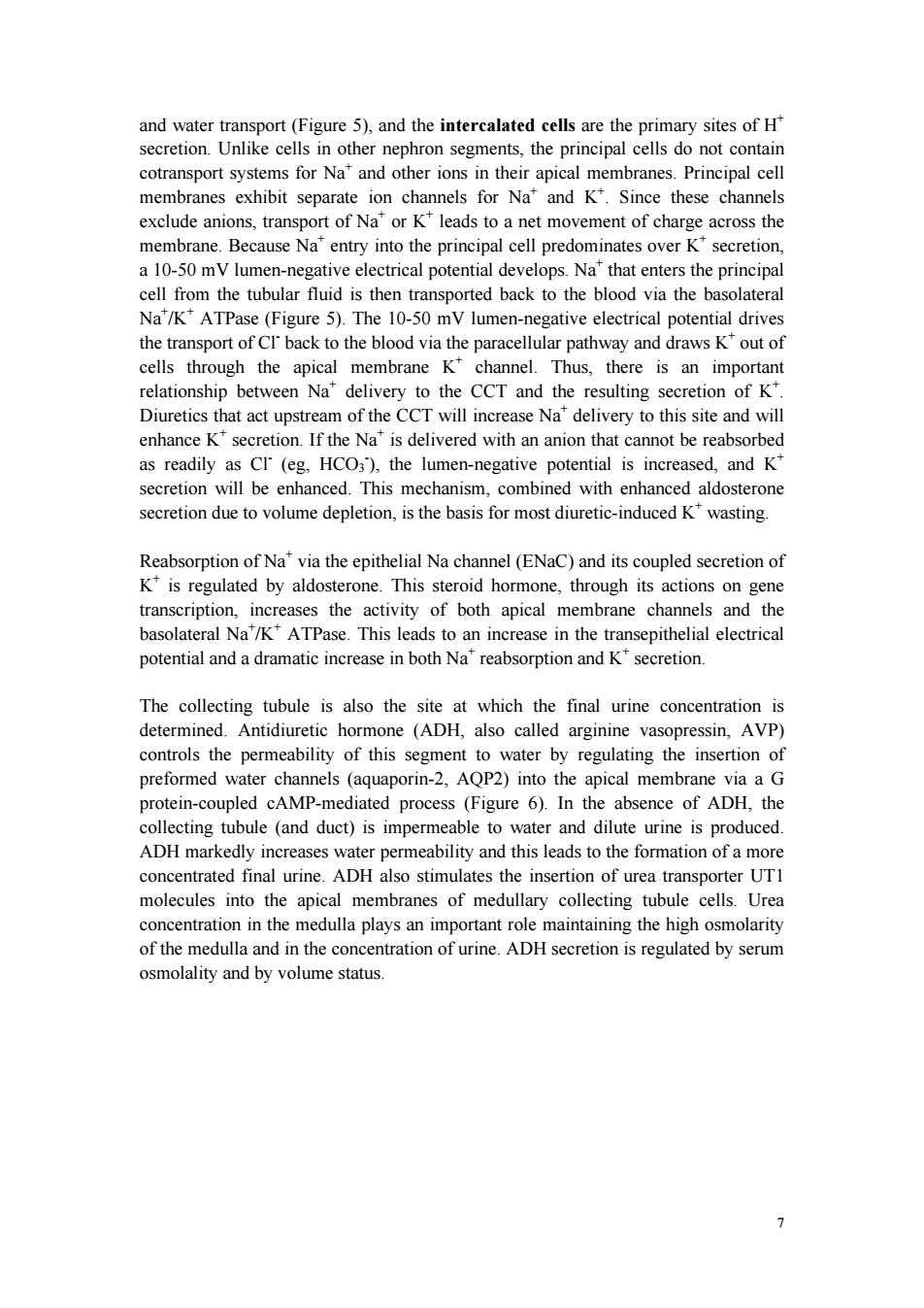正在加载图片...

and water transport(Figure 5),and the intercalated cells are the primary sites of H secretion.Unlike cells in other nephron segments,the principal cells do not contain cotransport systems for Na*and other ions in their apical membranes.Principal cell membranes exhibit separate ion channels for Na and K*.Since these channels exclude anions,transport of Na*or K*leads to a net movement of charge across the membrane.Because Na"entry into the principal cell predominates over K"secretion, a 10-50 mV lumen-negative electrical potential develops.Na*that enters the principal cell from the tubular fluid is then transported back to the blood via the basolateral Na/K*ATPase(Figure 5).The 10-50 mV lumen-negative electrical potential drives the transport of Cl back to the blood via the paracellular pathway and draws K out of cells through the apical membrane K channel.Thus,there is an important relationship between Na'delivery to the CCT and the resulting secretion of K" Diuretics that act upstream of the CCT will increase Na'delivery to this site and will enhance K secretion.If the Na'is delivered with an anion that cannot be reabsorbed as readily as Cl(eg,HCO3),the lumen-negative potential is increased,and K" secretion will be enhanced.This mechanism,combined with enhanced aldosterone secretion due to volume depletion,is the basis for most diuretic-induced K'wasting. Reabsorption of Na*via the epithelial Na channel(ENaC)and its coupled secretion of Kis regulated by aldosterone.This steroid hormone,through its actions on gene transcription,increases the activity of both apical membrane channels and the basolateral Na/K*ATPase.This leads to an increase in the transepithelial electrical potential and a dramatic increase in both Na'reabsorption and K*secretion The collecting tubule is also the site at which the final urine concentration is determined.Antidiuretic hormone (ADH,also called arginine vasopressin,AVP) controls the permeability of this segment to water by regulating the insertion of preformed water channels (aquaporin-2,AQP2)into the apical membrane via a G protein-coupled cAMP-mediated process (Figure 6).In the absence of ADH,the collecting tubule (and duct)is impermeable to water and dilute urine is produced. ADH markedly increases water permeability and this leads to the formation of a more concentrated final urine.ADH also stimulates the insertion of urea transporter UT1 molecules into the apical membranes of medullary collecting tubule cells.Urea concentration in the medulla plays an important role maintaining the high osmolarity of the medulla and in the concentration of urine.ADH secretion is regulated by serum osmolality and by volume status. 17 and water transport (Figure 5), and the intercalated cells are the primary sites of H+ secretion. Unlike cells in other nephron segments, the principal cells do not contain cotransport systems for Na+ and other ions in their apical membranes. Principal cell membranes exhibit separate ion channels for Na+ and K+ . Since these channels exclude anions, transport of Na+ or K+ leads to a net movement of charge across the membrane. Because Na+ entry into the principal cell predominates over K+ secretion, a 10-50 mV lumen-negative electrical potential develops. Na+ that enters the principal cell from the tubular fluid is then transported back to the blood via the basolateral Na+ /K+ ATPase (Figure 5). The 10-50 mV lumen-negative electrical potential drives the transport of Cl- back to the blood via the paracellular pathway and draws K+ out of cells through the apical membrane K+ channel. Thus, there is an important relationship between Na+ delivery to the CCT and the resulting secretion of K+ . Diuretics that act upstream of the CCT will increase Na+ delivery to this site and will enhance K+ secretion. If the Na+ is delivered with an anion that cannot be reabsorbed as readily as Cl- (eg, HCO3 - ), the lumen-negative potential is increased, and K+ secretion will be enhanced. This mechanism, combined with enhanced aldosterone secretion due to volume depletion, is the basis for most diuretic-induced K+ wasting. Reabsorption of Na+ via the epithelial Na channel (ENaC) and its coupled secretion of K+ is regulated by aldosterone. This steroid hormone, through its actions on gene transcription, increases the activity of both apical membrane channels and the basolateral Na+ /K+ ATPase. This leads to an increase in the transepithelial electrical potential and a dramatic increase in both Na+ reabsorption and K+ secretion. The collecting tubule is also the site at which the final urine concentration is determined. Antidiuretic hormone (ADH, also called arginine vasopressin, AVP) controls the permeability of this segment to water by regulating the insertion of preformed water channels (aquaporin-2, AQP2) into the apical membrane via a G protein-coupled cAMP-mediated process (Figure 6). In the absence of ADH, the collecting tubule (and duct) is impermeable to water and dilute urine is produced. ADH markedly increases water permeability and this leads to the formation of a more concentrated final urine. ADH also stimulates the insertion of urea transporter UT1 molecules into the apical membranes of medullary collecting tubule cells. Urea concentration in the medulla plays an important role maintaining the high osmolarity of the medulla and in the concentration of urine. ADH secretion is regulated by serum osmolality and by volume status